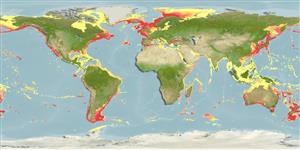Scyphozoa |
Semaeostomeae |
Ulmaridae | Aureliinae
Environment: milieu / climate zone / गहराई सीमा / distribution range
पारिस्थितिकी
पिलाजिक; खारा; गहराई सीमा 0 - 1250 m (संदर्भ 116114). Subtropical; 78°N - 55°S, 180°W - 180°E
Circumglobal. This species is widespread in all the seas of the sphere, from the equator to the poles. Subtropical to polar.
Length at first maturity / आकार / Weight / Age
परिपक्व अवधि: Lm ?, range 2 - 31 cm Max length : 50.0 cm WD पुल्लिंग / अलिंग; (संदर्भ 2376)
Maximum diameter: 50 cm (Ref. 358); Height, from 10 to 12.5 cm; diameter, being able to reach 40 to 50 cm (Ref. 363). Plane sunshade; comprising very many tentacles courts with the periphery. One counts 4 oral arms; and 4 sexual organs; of annular form or in the horseshoe shape very many radiate channels. Coloring: generally translucent, with slightly pink reflections, blue or purple; the sexual organs are more clearly colored red or pink (Ref. 358).
This species is being eaten by predators because of its high fatty acid content (Ref. 122155). Neritic, potentially pathogenic (Ref. 116114). Free living near the water's surface in pelagic zones (Ref. 2997), close to coasts (Ref. 358), and offshore (Ref. 813); also found in brackish waters (Ref. 2993), coastal embayments, fjords and estuaries (Ref. 3289). Their cnidocytes cannot transpierce the human skin. Suspension feeder (Ref. 3269) on tintinnids, rotifers, cladocerans and larvae of copepods (harpacticoid), barnacles (nauplii; Ref. 3053) and on fish larvae (Ref. 7715). Several cases reported sea anemones to feed on this species; fungiid coral is also an occasional feeder. Provides vital fatty acids for fishes and crustacean predators. Nutritional value of this species from macronutrients and key fatty acids appears to be important over only meeting a predator's energy demands (Ref. 122155).
High abundances of ephyrae during late autumn can be explained by the large number of poly disc scyphistomae preceding to the appearance of ephyrae (Ref. 3062). Polyps begin to develop in August-September, matures in October and dies in November (Ref. 3271). Budding doesn’t occur in winter months (Ref. 7721). Can live up to 2 years (Ref. 3049).
Wrobel, D. and C.E. Mills 1998 Pacific coasts pelagic invertebrates: a guide to the common gelatinous animals. Sea Challengers and the Monterey Bay Aquarium, Monterey, California.112 p. (संदर्भ 2376)
IUCN Red List Status
(संदर्भ 130435: Version 2025-1)
CITES status (संदर्भ 108899)
Not Evaluated
CMS (संदर्भ 116361)
Not Evaluated
Threat to humans
Human uses
मात्स्यिकी: व्यापारिक
| FishSource |
साधन
अधिक जानकारी
PhysiologyOxygen consumption
Human RelatedStamps, coins, misc.
इंटरनेट स्रोत
Estimates based on models
Preferred temperature
(Ref.
115969): 4.7 - 25.3, mean 12.3 (based on 3533 cells).
लौटाव
ऊंचा, न्यूनतम जनसंख्या दुगनी समय अवलागत 15 महीने। (K=0.45-3.83).
Fishing Vulnerability
Low vulnerability (25 of 100).
Price category
Unknown.
